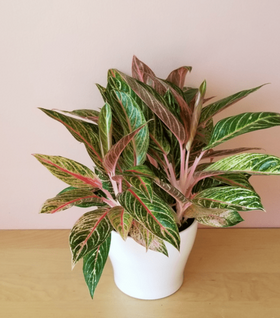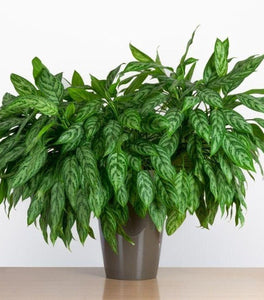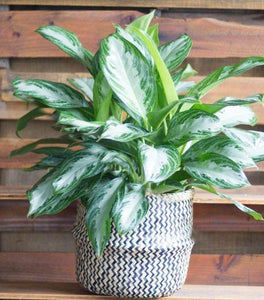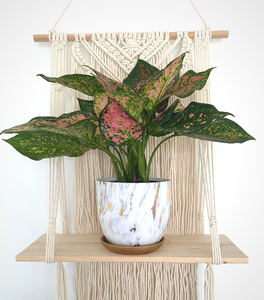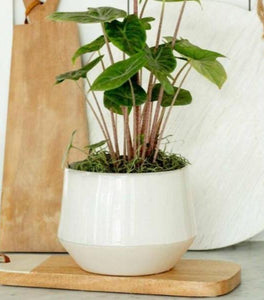Images Depict Mature Plants
Aglaonema Red Valentine for Sale Online
Aglaonema Red Valentine or Chinese Evergreen Red Valentine is a beautiful, slow-growing houseplant. The Red Valentine produces green leaves with tones of rose randomly splashed on the dark green leaves.
The colors start pink and turn red as the leaves mature. Chinese Evergreen plants are on NASA’s list of air-purifying plants. They have been shown to remove Benzene and Formaldehyde, which are can be present in home environments.
| Hardiness Zone: | 9-11 |
|---|---|
| Mature Height: | 30 to 36 Inches |
| Mature Width: | 30 to 36 Inches |
| Classification: | Colorful foliage |
| Sunlight: | Fluorescent to bright indirect |
| Habit: | Compact habit |
| Flower Color: | No flowers |
| Foliage: | Red with green |
| Soil Condition: | Likes to dry out some between watering |
| Water Requirements: | If unsure, do not water |
| Uses: | Attractive plant to be featured or in the background of any room in the house, does well with minimal care |
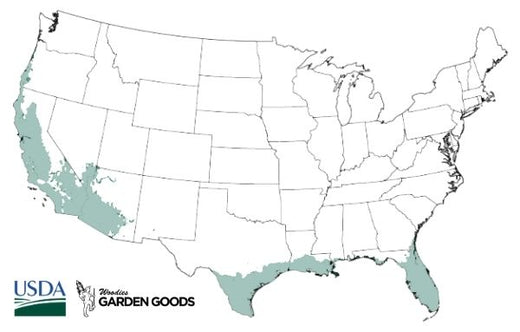
How to Care for Aglaonema Red Valentine
Be sure to read our planting instructions to ensure a healthy and happy plant for years to come!
How do I water Aglaonema Red Valentine?
Aglaonema Red Valentine should receive water relatively infrequently, as the plants like to dry out some between watering. The easiest way to tell if a plant needs water is by the weight of the container. If the container is heavy and the foliage is upright, chances are good the plant doesn't need water, whereas a light pot and limp foliage mean the plant needs some water. Sometimes, water pours out of the container without being retained by the soil. Soaking the dry potting soil in a small dish or saucer can be a way to solve this problem. If you're unsure, it is always better to let the plant go dry instead of drenching it with water. Moisture meters are another easy way to tell if plants need to be watered and usually come with a guide to indicate what number or level of different moisture plants require.
How do I fertilize Aglaonema Red Valentine?
Indoor houseplant fertilizers fall into two groups: water-soluble, liquid quick release, and granular, slow-release fertilizers. Jack's Classic Indoor plant food works well as a powder, quick-release fertilizer mixed with water to quickly provide nutrients to a plant that has been in a container for an extended time. Osmocote Indoor/Outdoor is an option as a granular, slow-release fertilizer while potting and planting. Any fertilizer offers nutrients that help plants with the transition to a new environment.

What is the best soil for Aglaonema Red Valentine?
The best soil for Aglaonema Red Valentine is a well-balanced mix of peat moss, perlite, and vermiculite that dries some between watering but takes a long time to compact. Typically, any reputable potting mix will work well and includes those ingredients. Adding a granular, slow-release fertilizer while planting is a great way to help the plant thrive in the transplanting transition.
How Do I Plant My Aglaonema Red Valentine Plant?
We suggest that you plant your Red Valentine houseplant in a container that is about 2 to 4 inches wider and 3 to 5 inches deeper than the nursery pot that it came in. Use well-draining potting soil, and be sure to loosen the roots of the plant when transplanting. We recommend adding a slow-release fertilizer to the new potting mix too. The most common cause of plant death after transplanting is planting the new plant too deep. We do not recommend planting your plant in a hole any deeper than the soil line in the pot. Keep in mind that this new potting mix will retain more moisture than the previous container, so watering, in the beginning, should be less frequent.







